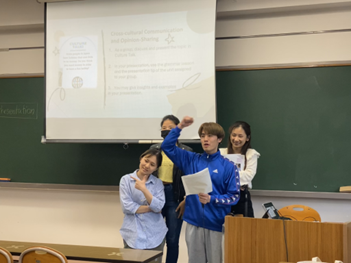Recently, second-year students from classes A and B of Advanced Communication 2 under the Tourism Department, led by Ms. Stelen Siagto and Ms. Liane Faye Andrade have joined forces for a class activity centered on culture sharing. Both professors recognized the potential synergies between their courses and organized a collaborative activity for the midterms to allow students to engage in a culture-centered discussion.

The Class Structure
Introduction
First, the theme of culture sharing was introduced to the students, and an overview of the session was provided. Then the students were divided into mixed groups containing both Class A and B. The nationality of the students was also considered for a more interesting discussion.
Group Work
All the topics were taken from the class textbook, Stretch 2. Each group was assigned a discussion prompt from each chapter related to cultural exchange, such as "What are some traditional dishes in your country? Do you like them?" and "Some people in Asia think that your blood type describes the kind of person you are. What are other ways of describing personalities?" To make it more challenging, they were required to use the grammar pattern that they learned from that chapter to explain their ideas and personal experiences.
Group Presentation and Class Discussion
Groups summarized their key takeaways from their discussion and presented them to the entire class. The class discussion was facilitated by both teachers, and the students reflected on what they learned about each other's culture while reviewing the useful grammar patterns they were assigned to. Finally, the session concluded with final thoughts from the professors, emphasizing the importance of cultural awareness and sensitivity.
Innovation and collaboration have great significance in enriching students' academic experiences and integrating different teaching approaches. Hence, this collaborative activity is an example of making efforts to enhance educational experience and promote innovation in the classroom.






